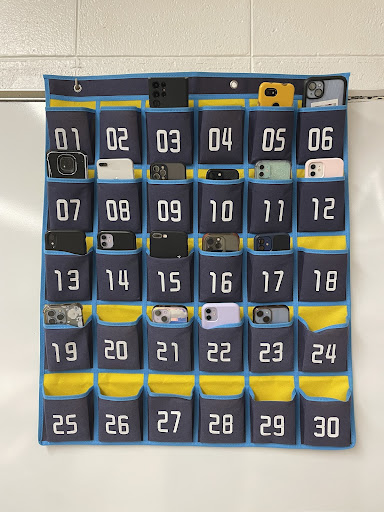The presence of cell phones in schools today is arguably one of the biggest factors affecting student learning and behavior. There are teachers that will say cell phones are a good thing, and others that will say the opposite.
Outside of school, they are expected to be used, but inside, not so much. There are teachers that may let students use their phones, but there are also others who will no. Teachers will base their rules on what they think works best for their classes, and they expect the students to follow through.
Teachers that do no allow their students use their phones in class have particular reasons why. Mrs. Walker says, “I do not let students use phones in class. They become a distraction, and even music makes it less likely students can concentrate on learning.”
However, Mrs. Walker states, “When cell phones became more commonplace, I stopped allowing them in the classroom. Initially, they just had to be off and out of sight, but now students “park” their phones in a designated space away from them so they can’t be tempted to sneak a peek at their phones.”

On the other hand, teachers that let their students use their phones in class typically have a system or practices to keep the class productive. Mrs. Nussbaum states, “Yes, sometimes [I allow phones]. I will allow students to listen to music. I also will allow students to check text messages quickly. I typically will say you have a minute to check a text, etc., and then when the lesson continues, phones away.”
Students may or may not agree with the rules, but they must adhere to the guidelines each individual teacher has set. Many students actually find it easier to focus and pay attention without their phone as a distraction.
Senior Madysen Barker says “I find it easier to focus when teachers don’t let us use our phones in class, because then I am more concentrated on the lesson and the homework, and not focused on the text messages or anything on my phone that will stop me from doing my work.”
Many students, though, prefer to have access to their cell phones during class, even though they may not focus as well because they are too worried what may be happening on or through their phone. Freshman Olivia Piwowarczyk states, “I do find it a little harder [to not have my phone] because I know my phone is my number one way of communicating to my parents if an emergency happens.”
There are students who push back on the varying rules regarding cell phone usage in class, and there are often different types of consequences that vary in severity. Mrs. Nussbaum says, “ I don’t really have too much trouble with phones. When I do, I have the student put their phone in the phone chart.”
In the classroom, cell phones can be a good thing when it comes to researching topics more efficiently, listening to music, and communicating with group members that may not be at school.
Mrs. Nussbaum states, “Students will play games to enhance the curriculum – oftentimes we allow them to use their phones for ease of access. Also, a quick lookup on vocabulary. Even a quick brain break to check a text. There are many ways a phone can be used as a tool for learning.”
On the other hand, cell phones can be a disadvantage because they can be distracting. Students may spend more time on their phones than actually paying attention. Mrs. Walker says, “Listening to music during lessons is a distraction. Our brains can’t multitask as well as students think [they can]. Having instant gratification is also an issue with phones. So many students don’t know how to be bored or how to work through lessons without turning to their phones for the answers immediately. Problem solving skills have been diminished.”
Clearly, cell phones can be a productive tool or a significant distraction from learning, but they are here to stay. Sandburg, like school communities everywhere, is learning to live and work with them one day at a time.



